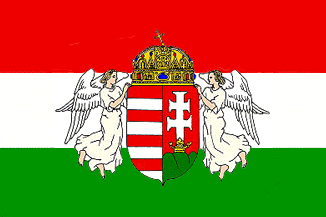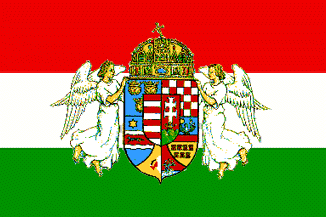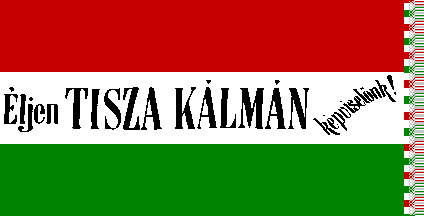
1867-1918, 1920-1946
image by Jaume Olle', 24 June 2001

Last modified: 2006-03-04 by dov gutterman
Keywords: hungary | horthy | habsburg |
Links: FOTW homepage |
search |
disclaimer and copyright |
write us |
mirrors
See also:
Other sites:

1867-1918, 1920-1946
image by Jaume Olle', 24 June 2001

1915-1918
image by Jaume Ollé, 10 March 2001
According to an old source - European flag book published in
1918, the flag of the Hungarian
kingdom (?) in 1918 was red,white,green holozontal
tricolour with Kossuth Arm/St.Stephen crown supported by two
Angeles which extended into the red and green stripes.
Proportion7:10. What is this flag used for and when ?
Nozomi Kariyasu, 21 January 2001
This flag is a Hungarian flag with the small Coat of Arms,
which was the only official Coat of Arms between 1920-1938. This
flag could be used 1882-1918 and 1920-1946. The angels show that
this flag is a Roman Catholic version.
István Molnár, 18 Febuary 2001
Does that means that there were several variations of the Coat
of Arms used at the same time differing in small elements
regarding the religious preferences (of those who use the arms?).
Željko Heimer, 20 Febuary 2001
The upper flag is the Hungarian kingdom flag according to an
U.K.Admilalty book published in 1918. According to Wappenlexikon
by Christian Siemer, this Coat of Arms of hu was used 1848 - 8
November 1868 and July 1919 - 1947 while Coat of Arms of the
second flag was used 15 October 1915 - March 1919
Nozomi Kariyasu, 10 March 2001 and 24 June 2001
What was the use of this flag during the Second World War?
Flaggenbuch shows as national flag the Hungarian tricolor with
lesser arms (the shield with the St. Stephen's crown), as
'national ensign, also used as service ensign. The tricolor
ensign without any arms is also shown, as 'national ensign
without arms'. Flaggenbuch shows also the 'middle' arms
('Mittleres' Staatswappen), similar to Nozmoi's design but with
slightly different angels (especially "facing" the flag
viewer) in the middle of a white field with the wolftooth border
as 'Standard des Reichwefers'.
Ivan Sache, 11 March 2001
I don't know this flag. I think if somebody use this flag it
never was official. The 'Middle Coat of Arms' was used on white
flag with wolfteeth. This version of the Middle Coat of Arms -
which contains the shield of Bosnia (bottom left yellow) was in
use in 1915-1918 and 1938-1944 (only on war flags). The Middle
Coat of Arms without the Bosnian shield was in use in 1882-1915.
The Hungarian national flag 1882-1918 was the red-white-green
without Coat of Arms. 1919-1944 with or without the Little Coat
of Arms. This Coat of Arms is not the Kossuth Coat of Arms!!
István Molnár, 11 March 2001
Last summer, when my family went to Budapest and London, they
bought me a replica of this flag, with the fly end
fringed... Only difference between the design pictured here
and my flag is that my flag has the entire Coat of Arms (shield,
Holy Crown and angels) all contained inside the white
stripe.
If the RC version had angels, what other versions were
there? I'm assuming there was a "Református"
version as well...
Georges G. Kovari, 21 March 2001
The Coat of Arms may be applied. On the white field, or
spread on the three fields? I didn't find a rule. The
angelic variation is at present unofficial.
Somewhere I found some information about how from 1882 on two
variations were acceptable for the Coat of Arms (small and middle
arms): The Catholic with angels, the Protestant with olive and
oak sprigs. My comment concerns to the flag with the small Coat
of Arms , not the flag with the middle Coat of Arms.
István Molnár, 21 March 2001
In 1849-1867 Hungary was under direct Austrian controll.
Didn't use Hungarian symbols. In 1867-1882 used the small Coat of
Arms (on flag) and a middle Coat of Arms (small Coat of Arms in
the heart of the shield around the Dalmatian, Croatian,
Sclavonian and Transylvanian Coat of Arms). 1882-1915 used the
small Coat of Arms (on flag) and a middle Coat of Arms (small
Coat of Arms in the heart of the shield around the Dalmatian,
Croatian, Sclavonian and Transylvanian Coat of Arms and Fiume's
Coat of Arms too!!!). In 1915-1918 used the small Coat of Arms
(on flag), and the Middle Coat of Arms (small Coat of Arms in the
heart of the shield around the Dalmatian, Croatian, Sclavonian
and Transylvanian Fiume's Coat of Arms and Bosnian Coat of Arms
too - on flag. Between November 1918 and March 1919 used only the
small Coat of Arms without crown (Kossuth Coat of Arms). Between
March1919 - August 1919 didn't used Coat of Arms, but red star.
Between August 1919 and 1920 used the small Coat of Arms with or
without crown. In 1920-1946 used the small Coat of Arms with
angels or olive branches on flag. All flags were the
red-white-green tricolour (Ratio of the Hungarian tricolour is
2:1 from 1848 not 3:2).
Countries on the used Coat of Arms:
1848-1849 small Hungary
1848-1849 middle Hungary, Dalmatia, Croatia, Slavonia,
Transylvania
1849-1860 no Coat of Arms
1867-1882 small Hungary
1867-1882 middle Hungary, Dalmatia, Croatia, Slavonia,
Transylvania
1882-1915 small Hungary
1882-1915 middle Hungary, Dalmatia, Croatia, Slavonia,
Transylvania, Fiume
1915-1918 small Hungary
1915-1918 middle Hungary, Dalmatia, Croatia, Slavonia,
Transylvania, Fiume, Bosnia
1918-1919 small Hungary (without crown)
1919 red star
1919-1946 small Hungary
1938-1944 middle Hungary, Dalmatia, Croatia, Slavonia,
Transylvania, Fiume, Bosnia (only on war flags)
István Molnár, 25 June 2001
At <www.trianon.hu>
there are photos from a ceremony that was held on 4th June 2001. This flag (close-up on the Coat
of Arms here) relates to the
Treaty of Trianon (1920) and the detached territories. The
original flag was in the Szabadság (Liberty) Square
between1928-1944. On that place you can see the Statue of the
Soviet Red Army.
István Molnár, 31 July 2001
1874.gif)
image by István Molnár, 23 March 2001
The greater Coat of Arms. On the center of the Middle Coat of
Arms there is the shield of the Habsburg-Lotharingien Dinasty.
First version: Used 1874-1915
István Molnár, 23 March 2001
Three version of Coat of Arms of Hungary were between
1874-1918
Smaller Coat of Arms: Same as the today Coat of Arms - Used
1874-1918 1919-1946 and 1989-
Middle Coat of Arms: First version: Without Bosnian arm: Used
1874-1915
Second version: With Bosnian arm: Used 1915-1918 and 1938-1944
Great Coat of Arms: On the center of the Middle Coat of Arms
there is the shield of the Habsburg-Lotharingien Dinasty.
First version: Used 1874-1915
Second version: 1915-1918.
István Molnár, 23 March 2001
This Coat of Arms was made to the king. You can see in the
great seal of the king below.
Source: Bertényi Iván: uj magyar címertan; Budapest
1998.
Information (in Hungarian) In the Pallas
Lexikon
István Molnár, 24 March 2001
kseal.gif)
image by István Molnár, 9 Febuary 2001
This was the official seal of the Kingdom of Hungary. In the
center of the seal there is the Great Coat of Arms of the Kingdom
of Hungary (before 1915). Great Coat of Arms means: on the center
of the Middle Coat of Arms there is the shield of the
Habsburg-Lotharingien Dinasty. the inscriptin means: FRANCIS
JOSEPH THE FIRST, EMPEROR OF AUSTRIA, KING OF CZECHIA ETC. AND
THE APOSTOLIC KING OF HUNGARY
Source: Bertényi Iván: uj magyar címertan; Budapest
1998
István Molnár, 9 Febuary 2001
Middle Coat-of-Arms of Hungary (Roman Catholic version), 1882 - 1915
mid82.gif)
image by Janko Ehrlich Zdvořák, 16 August 2001
Middle Coat-of-Arms of Hungary (Roman Catholic version).
Designs of Hungarian symbols were always different one from
another in their artistic realisation too. However, the essential
elements are required. This picture is scanned from
"Hickmanns Taschenatlas von Österreich Ungarn", G.
Freytag & Berndt, Vienna - Leipzig 1912.
Janko Ehrlich Zdvořák, 16 August 2001
This version was never official at this period.
István Molnár, 16 August 2001

Election flag for Kálmán Tisza in the 1870s
image by István Molnár, 5 February 2006
Yesterday I was in the Nemzeti Múzeum (HNM) and take some
photos of the election flag of Ferenc Deák in 1869 (Click 1,2 to see the photos) and election flag of Kálmán
Tisza in the 1870s.
Kálmán Tisza was the Prime Minister of Hungary 1875-1890. The
inscription: Éljen TISZA KÁLMÁN képviselonk! (Hurrah FOR
KÁLMÁN TISZA our representative!).
See also: <en.wikipedia.org>.
István Molnár, 5 February 2006